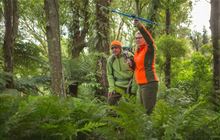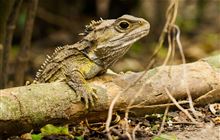Herpetofauna inventory and monitoring
Introduction
This module describes methods to inventory and monitor reptiles and amphibians.How to use this module
- Read project planning guides.
- Read the methods to inventory and monitor herpetofauna.
- Consult the introduction and the comparative tables and decision trees to help you select the method(s) most appropriate for your study.
- Be aware of the minimum data collection standards for methods.
- Check if any training is available for this method.
Introduction
How to decide the best method for herpetofauna monitoring (PDF, 757K)
Read this introduction and consult the comparative tables and decision trees to help you decide the method(s) best suited for your project objectives.
Methods
Field methods
The following methods can be used to inventory and monitor herpetofauna (reptiles and amphibians) in the field. Whether the species of interest are arboreal (tree) or ground-dwelling and the habitat they live in will largely determine the most suitable method to use.
Artificial retreats for herpetofauna (PDF, 1,643K)
This method uses artificial structures to detect the presence of species, particularly ground-dwelling lizards in open habitats.
Funnel trapping for herpetofauna (PDF, 1,226K)
Funnels traps can be used to detect a variety of arboreal and ground-dwelling lizards. Only use them when small mammal and centipede densities are low (because of the predation risk to lizards).
Pitfall trapping for herpetofauna (PDF, 1,311K)
This method detects ground-dwelling lizards in any habitat, taking care to exclude potential predators (e.g. mammals, crabs) with mesh or a lid.
Systematic searches for herpetofauna (PDF, 1,428K)
Timed searches can be used to find arboreal and ground-dwelling lizards (including tuatara) and frogs in optimal weather conditions.
Photo-identification of herpetofauna (PDF, 1,740K)
Photos of individual animals can identify their natural markings to monitor the movement and reproductive output of individuals and the size and productivity of populations.
Information-defined methods
These methods are used to estimate abundance of herpetofauna populations using the field methods described above. Determine your projects objectives beforehand to ensure you collect the minimum set of data that is required for data analysis.
Indices of abundance for herpetofauna (PDF, 1,381K)
Use this method to produce a simple index of abundance for comparison among sites with similar habitat or within a site across time.
Population estimates (using capture-mark-recapture data) for herpetofauna (PDF, 1,253K)
Use this method to monitor medium-large populations of tuatara, frogs and lizards where precise estimates are required and resources permit.


